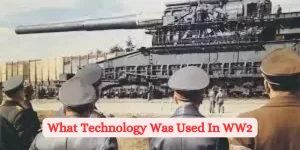What Technology Was Used in WW2
Introduction
World War II (WW2) marked a turning point in history, not only due to its geopolitical ramifications but also for the unprecedented technological advancements that characterized the conflict.
Radar and Sonar Innovations
In the midst of warfare, radar and sonar technologies emerged as game-changers. These innovations revolutionized reconnaissance, providing crucial information about enemy movements both in the air and underwater.
Radar: Eyes in the Sky
Radar, short for Radio Detection and Ranging, became a cornerstone in detecting incoming aircraft. Its application ranged from early warning systems to guiding fighter planes during aerial engagements.
Sonar: Beneath the Waves
In the naval arena, Sonar (Sound Navigation and Ranging) enabled the detection of submarines. This underwater technology significantly influenced naval strategies and anti-submarine warfare.
Codebreaking and Encryption
The art of codebreaking played a pivotal role in intelligence gathering. Advances in cryptography not only protected sensitive information but also allowed the deciphering of enemy codes.
Enigma Machine
The Enigma machine, used by the Axis powers, was a sophisticated encryption device. The Allied efforts to crack the Enigma code, led by figures like Alan Turing, contributed immensely to the war effort.

Atomic Bomb Development
Perhaps the most infamous technological development of WW2 was the creation of the atomic bomb. The Manhattan Project, a colossal scientific undertaking, culminated in the deployment of nuclear weapons on Hiroshima and Nagasaki.
Manhattan Project
The Manhattan Project brought together the brightest minds in physics, including Robert Oppenheimer and Enrico Fermi. This top-secret initiative harnessed nuclear fission, reshaping the nature of warfare and international relations.
Aviation Advancements
The war saw tremendous progress in aviation technology, with fighter planes, bombers, and jet engines taking center stage.
Jet Propulsion
The introduction of jet engines marked a paradigm shift in aerial warfare. Faster and more agile planes, such as the Messerschmitt Me 262, gave the Luftwaffe a temporary edge.
Strategic Bombing
Strategic bombing, utilizing long-range bombers like the B-17 Flying Fortress, played a significant role in shaping the war. The devastating impact of bombing raids on cities influenced military strategies and civilian morale.
World War 2 was a crucible of technological innovation. From radar and codebreaking to atomic weapons and aviation advancements, the war reshaped the technological landscape and set the stage for the post-war era.
Advanced Integration Technologies
Advanced Integration Technologies (AIT) represent the cutting edge of technological convergence. AIT involves the seamless blending of diverse technologies to create interconnected systems that enhance efficiency and functionality. In the context of modern industries, AIT plays a pivotal role in streamlining processes, improving automation, and fostering innovation. By integrating elements like artificial intelligence, Internet of Things (IoT), and data analytics, AIT enables organizations to adapt to dynamic challenges. advanced integration technologies The synergy of these technologies not only optimizes operational workflows but also opens doors to new possibilities, paving the way for a smarter and more interconnected future.
